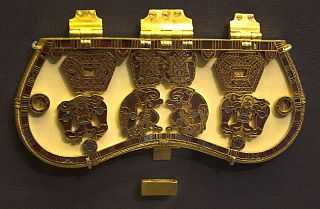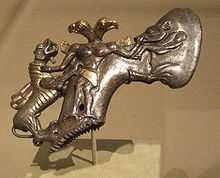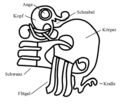Animal style

Animal style art is characterized by its emphasis on animal motifs, the term describing an approach to decoration from China to Northern Europe in the early Iron Age, and the barbarian art of the Migration Period. The zoomorphic style of decoration was used to decorate small objects by warrior-herdsmen, whose economy was based entirely on animals and plunder.[1]
Eastern styles
Scythian art makes great use of energetic animal motifs, one component of the "Scythian triad" of weapons, horse-harness, and Scythian-style wild-animal art. The cultures referred to as Scythian-style included Cimmerian and Sarmatian in the west in the European Sarmatia and stretched across the Eurasian steppe lands to the Ordos culture of China in the east, running north of the Near East, and were extremely influential in spreading many local versions of the style.
A distinct Permian style of copper alloys objects from around the 5th - 10th centuries CE are found near the Ural mountains and the Volga and Kama rivers in Russia.
Germanic animal style
The study of Germanic zoomorphic decoration was pioneered by Bernhard Salin[2] in a work published in 1904.[3] Salin classified animal art from roughly 400 to 900 into three phases. The origins of these different phases remain the subject of debate; developing trends in late-Roman popular provincial art was an element, as were proceeding traditions of the nomadic Asiatic steppe peoples. Styles I and II are found widely across Europe in the art of the "barbarian" peoples during the Migration Period.
Style I. First appearing in northwest Europe, first expressed with the introduction of the chip carving technique applied to bronze and silver in the 5th century. It is characterized by animals whose bodies are divided into sections, and typically appear at the fringes of designs whose main emphasis is on abstract patterns.
Style II. After about 560-570 Style I, declining, began to be supplanted. The animals of Style II are whole beasts, their bodies elongated into "ribbons" which intertwined into symmetrical shapes with no pretense of naturalism, rarely with legs, tending to be described as serpents- though heads often have characteristics of other animals. The animals become subsumed into ornamental patterns, typically interlace. Examples of Style II can be found on the gold purse lid (picture) from Sutton Hoo (ca. 625).
After about 700 localised styles develop, and it is no longer very useful to talk of a general Germanic style. [4] Salin Style III is found mainly in Scandinavia, and may also be called Viking art. Interlace, where it occurs, becomes less regular and more complex, and if not three-dimensional animals are usually seen in profile but twisted, exaggerated, surreal, with fragmented body parts filling every available space, creating an intense detailed energetic feel. Animals' bodies become hard for the unpractised viewer to read, and there is a very common motif of the "gripping beast" where an animal's mouth grips onto another element of the composition to connect two parts. Animal style was one component, along with Celtic art and late classical elements, in the formation of style of Insular art and Anglo-Saxon art in the British Isles, and through these routes and others on the Continent, left a considerable legacy in later Medieval art.
Other names are sometimes used: in Anglo-Saxon art Kendrick preferred "Helmet" and "Ribbon" for Styles I and II.[5]
-

Shaft-hole Axe Head with Bird-Headed Demon, a Boar, and a Dragon figurine. From Central Asia (Bactria-Margiana), late 3rd - early 2nd millennium BC.
-

Analysis of a bird from Broa, after whose finds the "Broa" style, a phase of Salin's Style III, is named.
See also
- Migration Period art
- Scythian art
- Thracian art
- Persian-Sassanid art patterns
- Confronted-animals
- Carolingian art
Notes
- ↑ Emma C.Bunker, Animal Style Art from East to West, Asia Society. p. 13
- ↑ Biography on swedish Wikipedia
- ↑ Die altgermanische Thierornamentik, Stockholm 1904, The Open Library online text, written in German and heavily illustrated.
- ↑ Rituals of power: from late antiquity to the early Middle Ages, By Frans Theuws, Janet L. Nelson, p. 45
- ↑ Hills
External links
- Perm Animal Style: Photo gallery (Virtual museum)
- Perm Animal Style
- Nomadic Art of the Eastern Eurasian Steppes, an exhibition catalog from The Metropolitan Museum of Art (fully available online as PDF), which contains material on and examples of animal style
